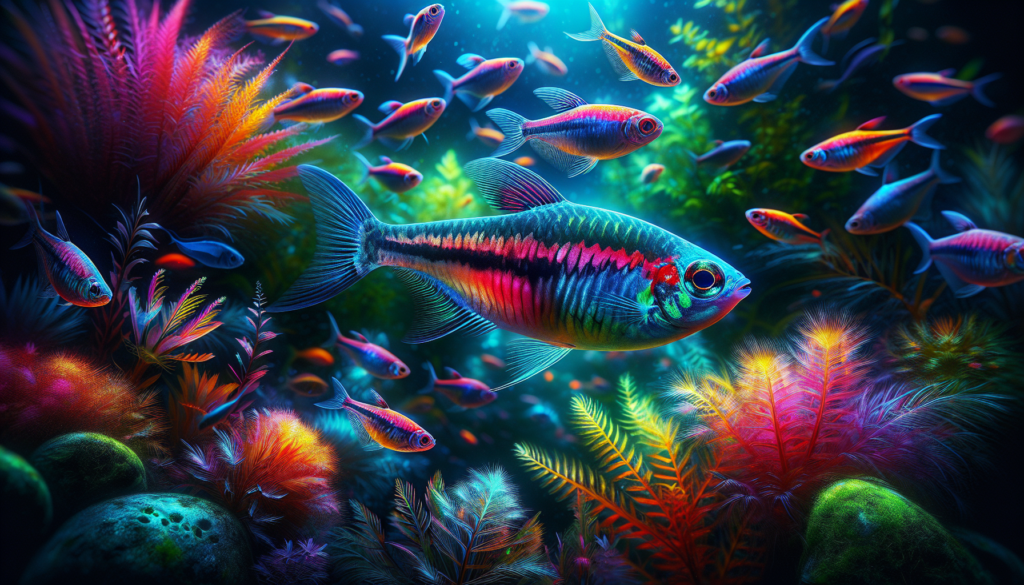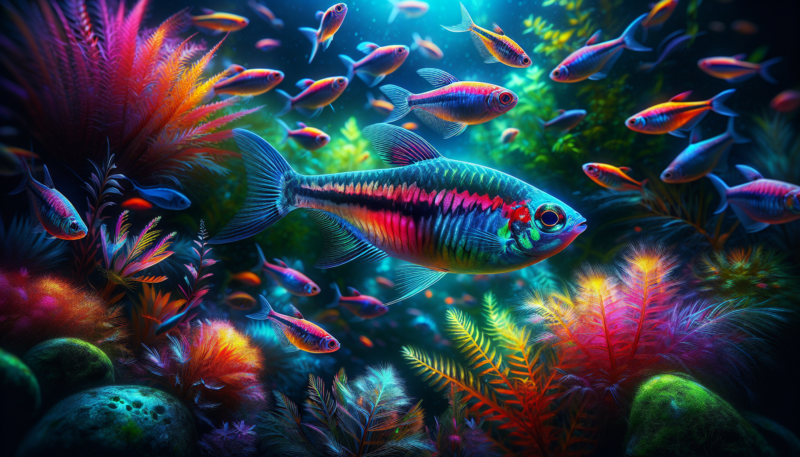Neon tetras, those vibrant and captivating little fish, are a popular choice for aquarium enthusiasts. You may be wondering just how long these delightful creatures can grace your tank with their presence. Well, wonder no more! In this article, we will explore the average lifespan of neon tetras, offering valuable insights into the factors that influence their longevity. From proper care to environmental conditions, we’ll uncover the secrets to ensuring these dazzling fish thrive for as long as possible. So, let’s dive into the fascinating world of neon tetras and discover how to keep them happily swimming by your side for years to come!
Introduction
Neon tetras are beautiful, vibrant fish that can be a delightful addition to any aquarium. Their striking colors and lively nature make them a favorite among fish enthusiasts. If you are considering adding neon tetras to your tank, it’s important to understand their natural habitat, lifespan, proper care requirements, signs of aging and diseases, breeding conditions, and how to increase their longevity. In this comprehensive article, we will explore all of these aspects to help you provide the best care for your neon tetras and ensure their well-being.
Natural Habitat of Neon Tetras
Origin
Neon tetras originate from the warm and gentle waters of South America, specifically the Amazon Basin and its surrounding areas. They are found in slow-moving streams, creeks, and flooded forests. These regions are characterized by dense vegetation, which provides the tetras with ample hiding places and shelter. The acidic water conditions and a temperature range of 68-77°F (20-25°C) make it an ideal habitat for these vibrant fish.
Environmental Factors
The natural environment of neon tetras offers crucial insights into their care requirements in captivity. They thrive in well-planted tanks that replicate their native habitat. A densely planted aquarium with floating plants, such as Indian ferns or Amazon frogbit, will give neon tetras a sense of security and mimic the shaded areas they would find in the wild. The tank should also have open swimming spaces to allow them to showcase their vibrant colors and energetic nature.

Lifespan of Neon Tetras
Average Lifespan
Neon tetras typically have an average lifespan of 3-5 years when provided with proper care. However, with ideal conditions and optimal care, some neon tetras have been known to live up to 8 years or even longer. The lifespan of neon tetras can be influenced by various factors, including genetics, water conditions, diet, and overall health.
Factors Affecting Lifespan
To ensure your neon tetras live a long and healthy life, it’s important to consider the factors that can impact their lifespan. Providing a suitable and well-maintained environment is essential. Poor water quality, incompatible tank mates, and improper nutrition can decrease their lifespan. Additionally, stress caused by overcrowding, sudden changes in water parameters, or inadequate care can also shorten their lifespan.
Proper Care for Neon Tetras
Tank Size and Setup
Neon tetras are relatively small fish, reaching about 1.5 inches (4 cm) in length. However, they are active swimmers and require enough space to move around comfortably. A minimum tank size of 10 gallons (38 liters) is recommended for a group of neon tetras. Remember, the more spacious the tank, the happier and healthier the fish.
Water Conditions
Maintaining suitable water conditions is vital for the well-being of neon tetras. They prefer slightly acidic water with a pH range of 5.5-7.0. It’s recommended to also keep the water hardness between 1-10 dGH (degrees of General Hardness). Regular water changes of 15-20% every week can help maintain optimal water parameters and prevent the accumulation of toxins.
Feeding
Neon tetras are omnivorous and have a varied diet in their natural habitat, consisting of small insects, larvae, and algae. In captivity, they readily accept commercial flakes, pellets, and frozen foods specifically formulated for tropical fish. Supplement their diet with occasional live or frozen foods like bloodworms or brine shrimp to provide them with additional nutrients.
Tank Mates
When choosing tank mates for your neon tetras, it’s important to select species that are peaceful and compatible with their gentle nature. Opt for small, non-aggressive fish like guppies, corydoras catfish, or smaller tetra species. Avoid keeping them with larger, aggressive fish that may see the neon tetras as prey or display territorial behavior.

Signs of Aging and Diseases in Neon Tetras
Physical Signs of Aging
As neon tetras age, their colors may fade, and they may lose their vibrant glow. They may also become slightly slower in their movements and less active. While these signs are natural and unavoidable, providing proper care can help delay the aging process and maintain their overall health.
Common Diseases
Neon tetras are generally hardy fish, but they can still be susceptible to certain diseases if the tank conditions are not optimal. Common diseases that can affect neon tetras include Ich (white spot disease), fin rot, velvet, and bacterial infections. Regularly monitoring their behavior, appearance, and water quality can help detect any signs of illness early on, allowing for prompt treatment.
Breeding Neon Tetras
Breeding Conditions
Breeding neon tetras can be a rewarding experience for fishkeepers. To encourage breeding, provide appropriate conditions similar to their natural habitat. This includes maintaining a temperature of around 77°F (25°C), low lighting levels, and adding a spawning mop or fine-leaved plants for them to lay their eggs on. It’s important to ensure there is sufficient hiding space for the eggs and the fry that will hatch.
Reproduction Process
Once the conditions are favorable, neon tetras will engage in a courtship dance. The male will initiate the process by chasing and nudging the female, leading to the release and fertilization of eggs. After breeding, it’s crucial to remove the adult tetras from the breeding tank, as they may consume the eggs or fry. The eggs will hatch in approximately 24-48 hours, and the fry can be fed infusoria or commercially available liquid fry food until they are large enough to consume newly hatched brine shrimp or finely crushed flakes.
Increasing Longevity in Neon Tetras
Maintenance of Water Quality
Clean and well-maintained water is essential for the overall health and longevity of neon tetras. Regular testing of water parameters, adequate filtration, and regular water changes are crucial to provide optimal conditions. Keeping the ammonia, nitrite, and nitrate levels in check will help prevent stress-related illnesses and ensure the well-being of your fish.
Balanced Diet
Providing a varied and balanced diet is key to enhancing the lifespan of neon tetras. Along with high-quality commercial flakes or pellets, offer them occasional treats of live or frozen foods. This will ensure they receive all the necessary nutrients to support their immune system, vibrant colors, and overall health.
Disease Prevention
Preventing diseases is always better than curing them. Quarantine any new fish before introducing them to your main tank to prevent the introduction of potential pathogens. Maintaining a clean tank, avoiding overstocking, and regularly monitoring your neon tetras for any signs of stress or illness will go a long way in preventing diseases and increasing their lifespan.
Myths and Misconceptions about Neon Tetras’ Lifespan
Belief in Short Lifespan
One common misconception about neon tetras is that they have a short lifespan. While it is true that they can be more delicate compared to some other fish species, with proper care, neon tetras can live for several years. By understanding their needs and providing them with optimal conditions, you can help ensure they live a long and healthy life.
Addressing Misconceptions
It’s important to address any misconceptions surrounding the neon tetra’s lifespan to avoid misinformation. By debunking false beliefs and providing accurate information about their care requirements, we can promote responsible fishkeeping and enable these beautiful fish to thrive in captivity.
Conclusion
Neon tetras are captivating fish that bring life and vibrancy to any aquarium. By understanding their natural habitat, lifespan, and proper care requirements, you can create an environment that allows them to flourish. Providing suitable tank conditions, a balanced diet, and monitoring their health regularly will contribute to increased longevity. By dispelling myths and misconceptions, we can ensure that neon tetras receive the care they deserve and continue to mesmerize fish enthusiasts for years to come.
